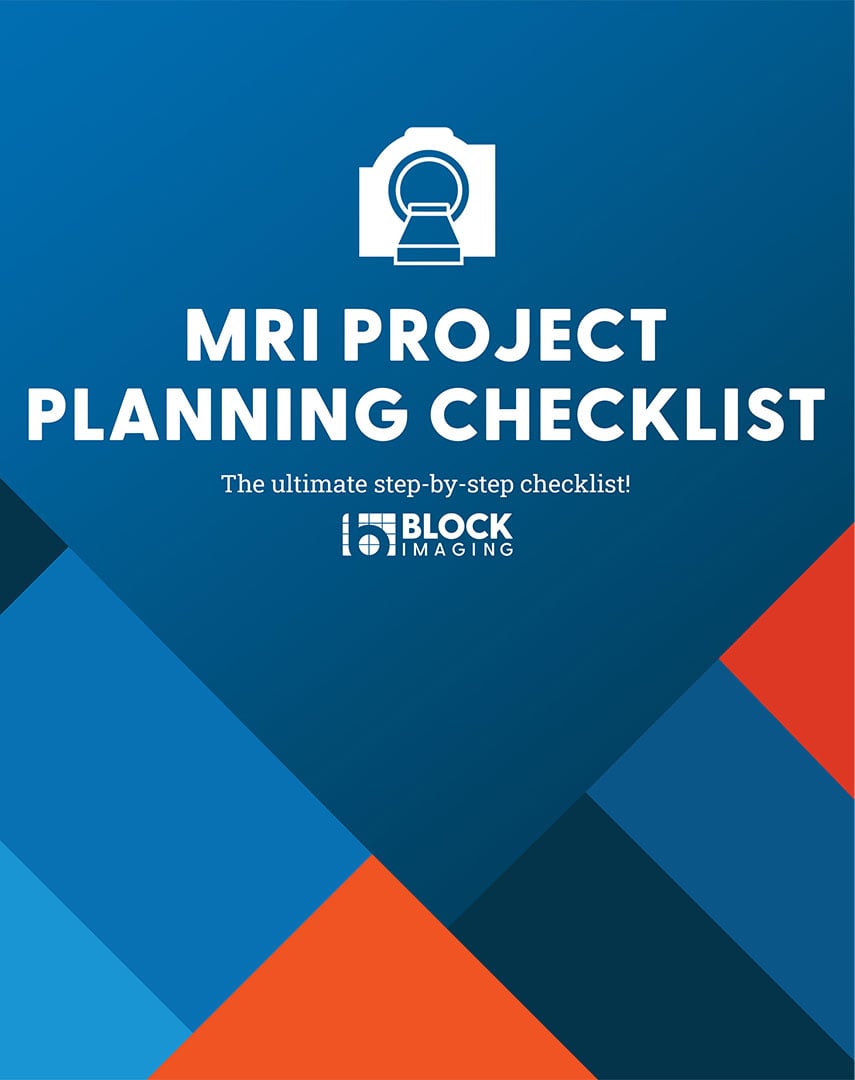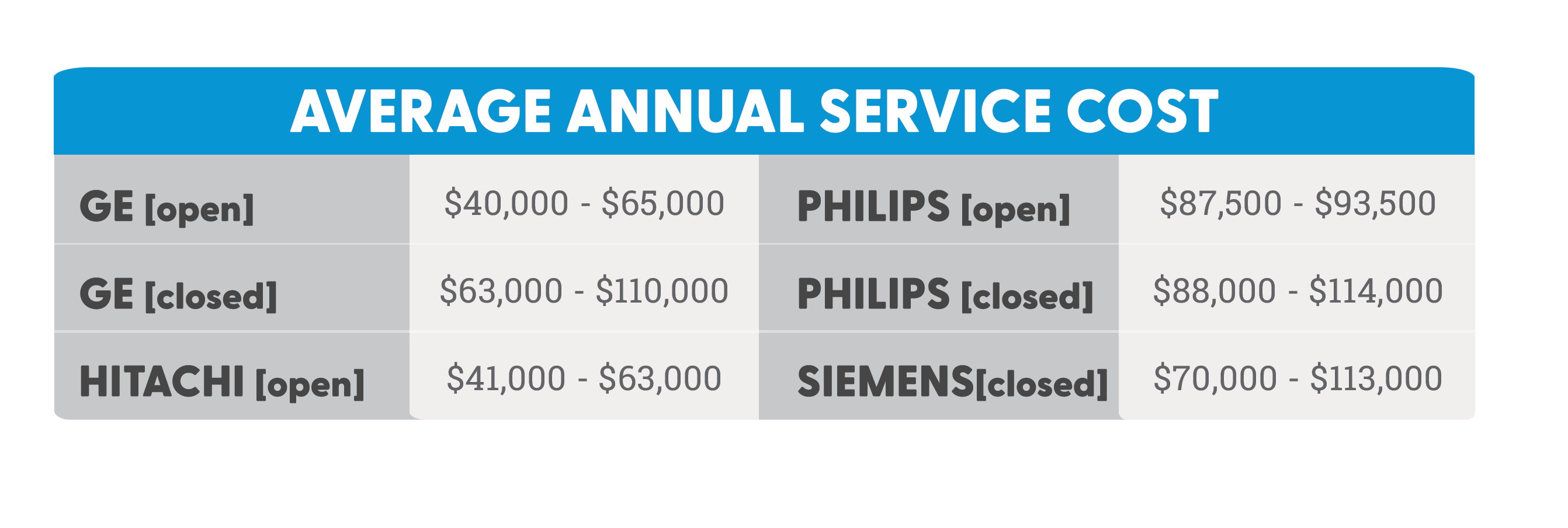2024 MRI MACHINE PRICE GUIDE
How much does an MRI machine really cost?
For MRI machine pricing you can expect to pay anywhere from 225K for entry-level machines and upwards of 500k for premium models.
We understand MRI machine pricing can be pretty confusing.
It's not as easy as picking something off the shelf. You have to consider magnet strength, image clarity, patient throughput, software options, and space capacity, not to mention service options if your MRI happens to go down.
This article delves into MRI machine prices and costs along with the specific machines you can purchase through Block Imaging. We’ll explore what features affect the cost of an MRI machine, which MRI price tier is right for you, and what other cost considerations you need to factor in when purchasing your machine.
- Features that affect the cost of an MRI machine
- Different MRI price tiers
- Other cost differences that should be considered
- More Resources
Note: Block Imaging was built to help you plan your next imaging project with confidence. A dedicated project manager is here to serve from inspection to de-installation, crating, rigging, transport, importation support, and installation. You can read about it in detail below or reach out to our sales team to learn more about how you can choose the perfect MRI machine for your hospital or healthcare facility.
What Features Affect the Cost of an MRI Machine?
1. Magnet Strength
The strength of an MRI system’s magnetic field is directly proportional to the level of detail in the images the system produces. Presently, there are magnets available in four main categories: 3.0T, 1.5T, 1.0T, and open/extremity magnets under 1.0T.
2. Image Clarity
Gradients in an MRI scanner, consisting of three smaller magnets, are crucial for affecting the scanner's image quality as they generate the magnetic fields for the X, Y, and Z planes, enabling precise imaging of specific body sections.
These gradient packages, while fundamentally serving the same purpose, vary significantly among different manufacturers and are named differently, such as "Twinspeed", "XGV", "Ultra", "Master", etc. The performance of these gradient systems is primarily evaluated using two metrics: amplitude and slew rate.
Amplitude measures the rate of change in the magnetic field across a distance, expressed in milliteslas per meter (mT/m), impacting the scanner's ability to detail certain body parts. Slew rate, indicating how quickly the system reaches its peak amplitude, is measured in teslas per meter per second (T/m/s) and affects the speed and efficiency of the imaging process.
The higher the amplitude and slew rate, the higher the cost of the MRI system. Although you’ll be getting more anatomical slices and clearer images, you’ll have to first determine if the additional costs can be justified by your patient volume and the type of studies you perform.
3. Patient Throughput
Throughput is the capacity of an MRI machine to efficiently perform a high volume of scans within a given timeframe, without compromising on image quality or operational efficiency. It is a critical factor to consider as higher throughput can lead to increased patient satisfaction by reducing wait times and more.
4. Software Options
With purchasing an MRI machine, the software options play a critical role in determining the machine's capabilities, efficiency, and the quality of the images it produces.
Each MRI system may come with its own proprietary software or offer compatibility with third-party options. It's important to consider not only the current needs but also potential future applications and upgrades when selecting software for an MRI machine.
Make certain that the software that you are purchasing meets your clinical need for the exams you intend to perform. The radiologists and technologists are a great resource to include in the process to guide you on which software and hardware to include on your purchase. Care should be taken so you do not over-purchase software that will not be used clinically.
5. Space Capacity
When discussing an "MRI suite," it refers to the specific set of rooms associated with the MRI machine itself, not the entire medical facility. This suite typically includes:
Scan Room: The primary area where the MRI machine and patient table are located, and where the actual scanning takes place.
Equipment Room: A room dedicated to housing the electronic equipment connected to the MRI magnet.
Control Room: The workspace for technicians operating the MRI, equipped with a desk, chair, and computer workstation.
Changing Room: An optional but common addition providing a space for patients to change clothes and for storing QA phantoms, manuals, or system accessories.
In terms of space requirements, constructing a new MRI suite demands approximately 800-850 square feet, including additional areas such as waiting rooms and hallways. For installations within existing facilities, around 650 square feet should be allocated or added for the suite. As for construction costs, a general estimate for new buildings is about $400 per square foot, though this can vary based on location, materials, suppliers, and builders.
Preparing your facility for an MRI installation may require you to work with engineers,
building contractors, electricians, architects, and any number of other specialists depending on how your existing building is set up. The costs for their services and the materials they’ll require will need to be determined on a case-by-case basis.
FREE Project Planning Checklist
PREPARE FOR THE MAJOR STEPS OF BRINGING IN A NEW MRI MACHINE!
A step-by-step guide for successfully bringing a new MRI into your facility.
Save yourself months of MRI project delays, headaches and surprises by knowing exactly what to prepare for.
Be your facility's MRI project planning superhero!

WHICH MRI PRICE TIER IS RIGHT FOR YOU?
We can break down MRI machines into three main price tiers—entry-level, intermediate, and premium—each offering distinct features to match a range of clinical needs and budgets.
With the budget-friendly entry-level models starting at $225K or the advanced premium machines at $500K and above, there are several options to consider when choosing an MRI for your healthcare facility.
$225k-$300k
Entry-Level
Features
1.5T, 4-8 Channels
Systems
GE LX, Excite II & Excite HD,
Philips Achieva & Intera
Siemens Symphony 4ch & 8ch
$325k-$500k
Intermediate
Features
1.5T, 8 or more Channels
Systems
3.0T GE Excite HDXT 1.5T & 3.0T
Philips Achieva (later models)
Siemens Acanto, Espree, and Trio
$500k+
Premium
Features
3.0T - High Channels - Wide Bore
Systems
GE Optima 450W
Discovery 750w
Philips D-Stream and Ingenia
Siemens Aera, Skyra, and Verio
Entry Level
When you're in the market for MRI machines for your healthcare facility, understanding the value of entry-level models is key. These machines are budget-friendly, priced between $225K and $300K, yet don't skimp on quality. They offer specifications like 1.5T - 4 to 8 Channels, balancing affordability with the advanced imaging features you need.
Popular models in this cost bracket include the GE LX, Excite II, & Excite HD, Philips Achieva & Intera, and Siemens Symphony 4ch & 8ch. For facilities aiming to purchase their first MRI system or enhance their current imaging solutions economically, this range presents an ideal solution.
Intermediate
If you're considering an upgrade in MRI technology within a sensible budget, the intermediate price range of $325K to $500K brings a suite of advanced features to the table. Equipped with 1.5T and offering 8 or more channels—and in certain cases, up to 3.0T—these machines deliver sharper, more detailed images, enhancing diagnostic precision.
Good systems in this category include the GE Excite HDXT in both 1.5T and 3.0T, later models of Philips Achieva, as well as the Siemens Avanto, Espree, and Trio. This price range is ideally suited for healthcare facilities aiming to bolster their imaging capabilities with more sophisticated technology, without venturing into the top-tier pricing.
Premium
For medical facilities aiming for the highest in MRI technology, the premium tier offers state-of-the-art machines starting at $500k. These models come equipped with powerful 3T magnets, extensive channel capabilities, and patient-friendly wide-bore designs.
A couple of systems within this range include GE's Optima 450W and Discovery 750W, along with Philips' D-Stream and Ingenia, and Siemens' Aera, Skyra, & Verio. Ideal for establishments seeking advanced image quality for intricate diagnoses, this tier represents the ultimate investment in patient care through cutting-edge imaging solutions.
What other cost differences should be considered?
When buying an MRI machine, consider both the upfront cost and future maintenance expenses, choosing from open, closed, or wide-bore models to match your budget and quality needs.
Open MRIs are more comfortable and affordable, closed MRIs offer superior image quality, and wide-bore models balance both but at a higher cost, so factor in all related expenses for a well-rounded decision.
Cost Differences Between Open, Closed, and Wide-Bore MRI machines
New wide-bore MR machines can cost upwards of $1 million, refurbished units of a similar type might be available in the range of $200,000 to $700,000 depending on their condition and specifications. Pre-owned wide-bore MRI machines typically sell for $500,000 to $700,000.
Closed MRI systems can be found pre-owned at lower price points, with models ranging roughly from $400,000 to $600,000 depending on the specific system.
Navigating Accreditation, Site Preparation, and Logistics
Even more things to consider when purchasing an MRI: accreditation, site setup, and the logistics involved.
Accreditation: The financial impact here hinges on your chosen accreditation organization and the extent of adjustments needed to align your facilities with their benchmarks. Given the variability of these costs, initiating early planning is advisable.
Site Setup: Tailoring your premises for an MRI machine encompasses engaging with a variety of experts, including engineers, building contractors, and electricians. The expenditure for their expertise and required materials is unique to each scenario.
Logistics: This component's expenses differ based on your premises' specifics and location. Removing an existing MRI could set you back around $10,000 and take a few days.
For moving the machine out, budget approximately $10,000 to $12,000 for standard situations, though complex removals may lead to higher costs.
Transport fees for shipping within the country typically fall between $5,000 and $10,000. Setting up a new MRI system, which involves intricate technical tasks, is likely to cost between $50,000 and $80,000 for a standard 1.5T MRI setup, with helium and other critical supplies adding to the budget.
Service
Here are the current averages annual service cost for MRI systems in fixed locations:- GE [open] $40,000 - $65,000
- GE [closed] $63,000 - $110,000
- Philips [open] $87,500 - $93,500
- Philips [closed] $88,000 - $114,000
- Hitachi [open] $41,000 - $63,000
- Siemens [Closed] $70,000 - $113,000
Service numbers for these systems need to be addressed on a case-by-case basis. Key features within MRI Service include helium (cryogen), preventative maintenance visits, coils, chiller, parts, labor, travel, and overtime coverages.
It's also important to consider that the length of terms (1, 3, or 5-year agreement) plays a significant part in the cost of a service agreement. 1-year terms are more expensive than 5-year terms.
The longer the terms of an agreement the more we can spread our risk.
Final Thoughts
Selecting the right MRI machine also means considering different price tiers, from budget-friendly entry-level models to advanced premium machines, each offering unique features and capabilities.
Block Imaging helps demystify these options, providing clarity on the benefits of open, closed, and wide-bore MRIs within each price range. This ensures you find an MRI that not only meets your clinical and operational needs but also aligns with your financial planning.
With Block Imaging's support, navigating the complexities of MRI selection, including price tiers, becomes a seamless part of enhancing your healthcare services.
4 min read
MRI Coil Cost Price Guide
Apr 3, 2024 by Andy Jarvis
4 min read
MRI System Comparison: Open, Closed, and Wide-Bore
Apr 3, 2024 by Steve Rentz




